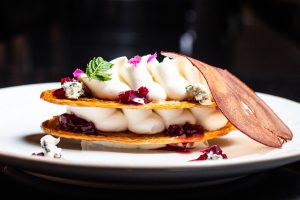On the Road (to the World’s Best Restaurants)
How the MICHELIN Guide got its start in giving stars
When brothers Andre and Edouard Michelin founded their tire company in 1889 in the small town of Clermont-Ferrand, France, there were less than 3,000 cars in the country. To help encourage road tourism—and, therefore, tire sales—they developed a small red guidebook featuring useful, on-the-road information (including maps, tire-changing instructions, and locations to refuel and recharge).
The company launched the MICHELIN Guide in 1900 with 35,000 copies. Upon growing demand, they debuted Guides in other European countries (beginning with Belgium in 1904). It wasn’t until the 1920s that the Guides began to include a list of restaurants by category to visit—a section that became so popular, the company began hiring anonymous diners to vet establishments. In 1926 the Guide began awarding stars to dining venues, using a single star distinction for them all—and in the decade that followed, the team determined their one-, two-, and three-star ranking system for which they are known today.
The United States welcomed the MICHELIN Guide in 2006 with its New York City Guide, helping to bring even more recognition to the Big Apple’s thriving dining scene. In the years that followed, Michelin established its presence in other U.S. culinary capitals, such as San Francisco, Chicago, and Washington D.C. Today, the MICHELIN Guide rates more than 15,000 establishments across more than 40 destinations.
America continues to see the Guide grow from coast to coast, each one’s arrival revealing expert restaurant picks across several categories—those that have earned a star (or multiple), the Bib Gourmand accolade (for venues featuring “good quality, good value cooking”), or a MICHELIN Recommendation (for venues using “quality ingredients that are well cooked”). Those thoughtful selections continue to spur on the hospitality industry like none other, all while carrying out much of the Michelin brothers’ original mission—to inspire adventure seekers everywhere to make restaurant bookings and pack their bags.
Colorado, Atlanta, and Miami are some of the newest parts of the United States being explored by the MICHELIN Guide’s team of anonymous inspectors. Read on for a taste of each region’s restaurants, from once-in-a-lifetime experiences to everyday favorites.
Atlanta
The Atlanta Guide features more than 40 restaurants, with nearly a dozen of them Bib Gourmand recipients (including seafood favorite Fishmonger and Southern-Korean BBQ staple Heirloom Market).

Photo: ATLAS; Lorenzo Franco
Five restaurants here have received one star—visit sushi destination Hayakawa for pristine nigiri; Midtown’s Lazy Betty for refined, contemporary fare that pays familial homage, or New American mainstay Bacchanalia, where menus are rooted in seasonal, organic finds (many of which are sourced from the team’s farm). And at Atlas (pictured), experience chef Freddy Money’s tasting menu, an eight-course spectacle that changes with the seasons (available options for vegetarians and vegans, as well).
Miami
The MICHELIN Guide Ceremony revealing the 2024 selection for Miami, Tampa and Orlando takes place this month, but currently, Miami boasts 75 MICHELIN-recognized restaurants (including 18 Bib Gourmand recipients and a dozen starred spots).

Photo: Le Jardinier; Pear Arlette
Of the former, try the house-made pastas at Michael’s Genuine, delectable pastries from Zak the Baker, and a few of the East Coast-famous pies from Lucali (an outpost of the beloved Brooklyn fixture). Two-star restaurant L’Atelier de Joel Robuchon Miami ensures a memorable experience akin to that of its global counterparts, and 11 restaurants hold a one-star designation—including El Cielo (with its Colombian-inspired cooking), sushi must The Den at Azabu, and The Four Seasons’ Surf Club Restaurant (chef Thomas Keller’s Florida debut). At Le Jardinier (pictured), culinary director Alain Verzeroli and chef de cuisine Christian Pasco Diaz serve a four-course menu reflecting their produce-driven philosophies. Those seeking a more relaxed dining experience can find it at the restaurant’s bar, where a medley of impressive bites await (think petite lobster rolls and gruyere cheese gougeres).
Colorado

Photo: Frasca Food & Wine
When the Colorado Guide launched in 2023, it brought with it 44 restaurants across the state. Nine of them are of Bib Gourmand status, including Denver’s Hop Alley (frequented for its bold, contemporary Chinese cuisine) and Boulder’s Basta (well-praised for its innovative takes on pizzas and small plates). Five Colorado restaurants have earned a star—Denver’s Bruto, The Wolf’s Tailor, and tasting menu parlor Beckon; popular New American spot Bosq in Aspen, and in Boulder, Frasca Food & Wine (pictured), where the menu serves as love letter to Colorado and Northeast Italy. Don’t miss a chance to visit their sister spots in Denver—the musically inclined wine bar Sunday Vinyl and, for more epic Italian fare, the Bib Gourmand-clad Tavernetta.
Source: Michelin Guide USA
_
This story appears in One Adventures, Berkley One’s digital magazine celebrating creators, experiences and stories. Read the issue here.
–
Berkley One is a Berkley Company.



